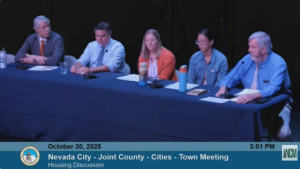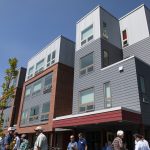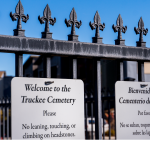Joint housing meeting for Nevada County addresses rising need
NEVADA COUNTY, Calif. – On Thursday, representatives from Truckee, Grass Valley, Nevada City and Nevada County met in Nevada City to discuss the housing needs in the region.
Regional housing needs allocation
One of the major changes for county is the seventh cycle of its regional housing needs allocation (RHNA), which include adjustments for vacancy rates, cost-burden, homelessness, and seasonal, recreational and occasional use for homes.
RHNA is a program that requires cities and counties to adequately plan to meet the housing needs of their communities. These are addressed by housing elements, which outline plans to meet community housing needs.
Truckee, as an area with seasonal tourism, has roughly 50% of its housing stock as second homeowners. The county has a 10% cap on the vacancy rate adjustment that would address it, but concerns about being “punished” for that while also relying on a tourist economy were brought up during the meeting.
Other areas also asked about appealing the RHNA numbers. While incentives for zoning could help address these issues, Nevada City worried about the lack of land. However, if they challenged their RHNA, the number of units they could not meet would be shifted to another jurisdiction in the area.
Planning panel
Principal planner of Truckee Yumie Dahn was part of a planning panel discussing housing elements and needs. Dahn spoke about the challenges in creating these housing elements.
“Time is one of the biggest challenges,” said Dahn. She also addressed rezoning as a potential future hurdle, as density increases would disregard the community’s input in general plans.
Dahn also touched on the difficulties of fire insurance and codes, as well as the cost of construction. “State laws aren’t necessarily focusing only on affordable housing… a lot of developers would rather construct luxury homes over affordable units.”
Truckee’s zoning is currently appropriate to meet RHNA needs, and since the sixth housing element, developers have constructed 65% of their very low housing needs and 80% of their low. Much of the funding for this has come from state and federal sources. Truckee is also zoning housing for school district employees and students.
The accessory dwelling unit (ADU) program has been successful in Truckee, as it has been in the county. Truckee has created 109 ADUs and junior ADUs since 2018. They also have approved some density bonus units to help address RHNA.
Dahn expressed a continued interest in working with local agencies and Placer County to address housing needs. She also noted Pacific Crest Commons and the Excess Sites program as a pathway for identifying public lands that could be surplus and used for affordable housing.
Workforce housing
Lynn Baumgartner, housing analyst in Truckee, was joined by Isaac Landman of Placemate and Heidi Allstead, executive director of the Tahoe Truckee Community Foundation (TTCF) to discuss workforce housing.
Baumgartner helped to define workforce housing, which focuses on the local workforce that serves the community. She noted that in Truckee, there’s a development code piece that Dahn is working on that will help with creating workforce housing.
Landman spoke about the Rooted Renters and Lease to Locals programs that Placemate helps to administer in Truckee. These programs focus on missing middle housing, which serves up to 150% of the area median income.
Lease to Locals incentivizes conversion from short-term rentals or not renting at all to renting long-term for locals, while Rooted Renters looks to incentivize renting workforce units at below market prices for at least three years.
According to Landman, the average adult income is just under $60,000 in Truckee, so they are typically serving the lower area median income. Additionally, 71% of the 198 properties who have graduated from the Lease to Locals program have said they will continue to rent.
This year, Truckee dedicated $1 million to the Rooted Renters program, which saw much interest and success. The rents are on average, for the 54 properties of the pilot program, a little lower than $2,500 a month and will be locked into that for three years.
Allstead spoke about the evolution of TTCF and their seven member agencies, as well as the joint powers authority (JPA). She emphasized that JPAs can tackle shared challenges, have shared capacity and powers, a stronger funding position, authority and flexibility, streamlined services and long-term stability. She also listed some of the key partnerships with the town of Truckee, Placer County, Placemate, Mountain Housing Council and the Tahoe Housing Hub.
Baumgartner noted that their first project with Homegrown Housing will create 12 units, 2 that are low income and 10 that are deed restricted. “We’re hoping that it can be a model for future development in the region to help get some of that new housing on the ground,” she said.
Housing organizations
Geoship, the Regional Housing Authority, Soul Learning Institute and Nevada County’s Habitat for Humanity also spoke at the panel, addressing challenges and future goals.
Gus Becerra, executive director of the Regional Housing Authority, pointed out that while H.R. 1 made major improvements to the low-income housing tax credit program. That program funds many affordable housing projects, including ones like Sugar Pine Village in South Lake Tahoe. However, state funding has dried up.
Getting funding is a major challenge for every housing group, especially in trying to create housing for the “missing middle.” For example, Soul Learning Institute, which builds tiny homes, relies on local funding and leveraging assets. Others that have looked to state funding are planning to switch to federal funding if state funding continues to remain stagnant.
All of these groups also advocated for further collaboration, especially among politicians, local businesses and communities. Lorraine Larson, executive director of Habitat for Humanity, noted that they were interested in sharing costs of development with local organizations. She noted that there may be a new development in Truckee, though she didn’t share concrete details yet.
Eli Ramos is a reporter for Tahoe Daily Tribune. They are part of the 2024–26 cohort of California Local News Fellows through UC Berkeley.
Support Local Journalism


Support Local Journalism
Readers around Lake Tahoe, Truckee, and beyond make the Sierra Sun's work possible. Your financial contribution supports our efforts to deliver quality, locally relevant journalism.
Now more than ever, your support is critical to help us keep our community informed about the evolving coronavirus pandemic and the impact it is having locally. Every contribution, however large or small, will make a difference.
Your donation will help us continue to cover COVID-19 and our other vital local news.










